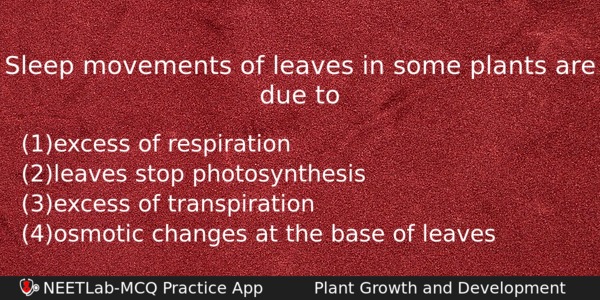| ⇦ | 
| ⇨ |
Sleep movements of leaves in some plants are due to
Options
(a) excess of respiration
(b) leaves stop photosynthesis
(c) excess of transpiration
(d) osmotic changes at the base of leaves
Correct Answer:
osmotic changes at the base of leaves
Explanation:
Sleep movement or nyctinasty (sleep movement during night) occurs in the leaves of many legumes and Oxallis is due to turgor changes in response to darkness. The leaves fold at night but open during the day. Leaves of Mimosa pudica also show sleep movement, called as seismonasty (shock movement) in response to physical contact, injury, electric current etc. The movement occurs due to osmotic changes.
Related Questions: - The degree of opening of stomata is determined by
- Why is a capsule advantageous to a bacterium?
- When a bottle of perfume is placed at one corner of a room and the lid opened
- In which one of the following options the two examples are correctly matched
- Stratification is found in
Topics: Plant Growth and Development
(126)
Subject: Biology
(4253)
Important MCQs Based on Medical Entrance Examinations To Improve Your NEET Score
- The degree of opening of stomata is determined by
- Why is a capsule advantageous to a bacterium?
- When a bottle of perfume is placed at one corner of a room and the lid opened
- In which one of the following options the two examples are correctly matched
- Stratification is found in
Topics: Plant Growth and Development (126)
Subject: Biology (4253)
Important MCQs Based on Medical Entrance Examinations To Improve Your NEET Score
18000+ students are using NEETLab to improve their score. What about you?
Solve Previous Year MCQs, Mock Tests, Topicwise Practice Tests, Identify Weak Topics, Formula Flash cards and much more is available in NEETLab Android App to improve your NEET score.
Share this page with your friends

Leave a Reply